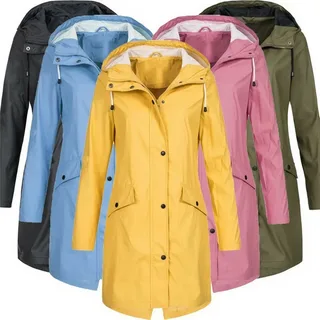What fabric is suitable for a raincoat?

Raincoats are one of the most popular types of seasonal clothing, especially useful during rainy and cold days. The primary purpose of these garments is to protect the body from rain and wind, but they also play an important role in one’s style and appearance. Therefore, selecting the right fabric for a raincoat is crucial. In this article, we will review the types of fabrics suitable for making raincoats, so you can make the best choice based on your needs and preferences.
For purchasing women’s raincoats, you can click on the linked word.
Key Features of the Best Raincoat Fabric
Before introducing the different types of suitable fabrics, it’s important to understand what characteristics a raincoat fabric should have:
- Waterproof: The most important feature of a raincoat is that it protects the body from getting wet. Hence, waterproof or water-resistant fabrics are ideal for raincoats.
- Windproof: In addition to blocking water, a raincoat should prevent wind from penetrating, which is especially important in cold weather.
- Breathability: The fabric should allow moisture to escape so that the body doesn’t sweat excessively, keeping you comfortable.
- Durability: Raincoats are often used in tough conditions such as heavy rain and wind, so durable fabrics that can withstand these elements are essential.
- Lightweight & Comfortable: While raincoats can be made from thicker fabrics, the garment should still be lightweight and comfortable, especially for those spending long periods outdoors.
Now that we understand the main features of suitable raincoat fabrics, let’s examine the different fabric types used in making raincoats.
1. Gore-Tex
Gore-Tex is one of the most well-known and popular fabrics for waterproof clothing, especially raincoats. It features a membrane that is waterproof and windproof while being breathable, allowing sweat vapor to escape but blocking water from getting in.
- Pros:
- High resistance to water and wind
- Excellent breathability
- Ideal for outdoor activities and sports
- Cons:
- Expensive
- Requires special care to maintain its waterproof properties
2. Nylon
Nylon is another widely used fabric for raincoats. Its lightweight and water-resistant qualities make it an excellent option. However, nylon is not fully waterproof by itself and usually needs to be combined with a water-repellent coating like polyurethane or DWR (Durable Water Repellent) to enhance its waterproof ability.
- Pros:
- Very lightweight
- Highly breathable
- Affordable
- Cons:
- May wear out faster than other fabrics with regular use
- Can become brittle in low temperatures
3. Polyester
Polyester is another common fabric for raincoats. It is water-resistant and can be treated with an extra waterproof layer. Polyester has better UV resistance than nylon and is less prone to discoloration over time.
- Pros:
- Good water resistance
- UV-resistant
- Relatively cheap and durable
- Cons:
- Less breathable than nylon or Gore-Tex
- Can feel warm and cause sweating in hot conditions
4. Vinyl
Vinyl is a synthetic waterproof fabric that is often used in urban and fashion raincoats. It is completely impermeable to water and offers excellent protection during heavy rain. However, due to its lack of breathability, it’s not ideal for physical or sports activities.
- Pros:
- Fully waterproof
- Affordable
- Stylish with a glossy look, great for fashion raincoats
- Cons:
- Not breathable
- Heavier than other fabrics
- Can cause sweating in warm weather
5. Waxed Cotton
Waxed cotton is a classic choice for raincoats, offering a natural and stylish look. This fabric consists of natural cotton that is coated with a layer of wax to make it water-resistant. Raincoats made from this fabric are typically more suited for everyday wear rather than sports or intense activities.
- Pros:
- Stylish and elegant appearance
- Water-resistant
- Long-lasting with proper care
- Cons:
- Heavier than synthetic fabrics
- Requires regular waxing maintenance to retain waterproofing
6. Polyurethane
Polyurethane is a synthetic material used as a coating on other fabrics to make them waterproof. It is lightweight and flexible and is often combined with nylon or polyester to enhance durability.
- Pros:
- Waterproof and windproof
- Highly flexible
- Suitable for various weather conditions
- Cons:
- Not very breathable
- May degrade and crack over time
7. Microfiber
Microfiber is a very lightweight and soft synthetic fabric that offers water resistance. Due to its lightness and comfort, it is a great option for raincoats designed for everyday use.
- Pros:
- Very lightweight and soft
- Good water resistance
- Breathable
- Cons:
- Less durable than some other fabrics
- Less resistant to wind
Conclusion | The Best Fabric for a Raincoat
Choosing the best fabric for your raincoat depends on your needs and the intended use. If you need a raincoat for sports or harsh weather conditions, fabrics like Gore-Tex or nylon are ideal. However, if you want a stylish raincoat for daily wear, waxed cotton or vinyl may be better suited.
In general, fabrics that are waterproof, durable, and breathable are the best choices for raincoats. Depending on your intended use, the climate, and personal preferences, you can choose the most suitable fabric from the various options outlined here.
